THE 900s — New Orleans Public Service Inc. — THE 900s
| DTAR | 900-972 | Same dim.
as
800-899 |
76-E2 | Perley A. Thomas Car Works |
ON 124 (900-911)
ON 126 (912-917)
ON 127 (918-972) |
Late 1923
1924
1924 | 73 cars |
|
| (Truck orders) | 10 | 76E2 | for GE 275 mot., 30" WH |
Brill ON 21861½ | 7/23/23 |
Prom. 9/17 | 12 sets
for 900-911 |
| | 14 | 76E2 | for WHSE 535 mot., 30" WH |
Brill ON 21861¾ | 7/23/23 |
Prom. 9/17 |
| | 110 | 76E2 | |
Brill ON 22021 | 4/1/24 |
Prom. 5/22 to 7/20 | 88 sets for remainder
of 900s & poss.
RB-RT Palace cars |
| | 66 | 76E2 | |
Brill ON 22026 | 4/28/24 |
Prom. 6/23 |
|
100 cars planned, which accounts for discrepancy in number of trucks ordered,
200 (100 pairs). The rest of the trucks used in various RB & RT
programs, for Palace cars and Semi Convertibles.
The 900s were practically mirror images of the 800s. P + text S pp.
151-158, scale drawings S pp. 154-155. See ERJ v. 67 no. 15 p. 632 -
P #906 as deliv. in 1924. RE has several P of 900s under construction
at Thomas Car Works. Both the 800s and the 900s used the Providence
Lifeguard Fender (the Herr was used for the last time on the 400s - see
S p. 150 and ERJ v. XLII, no. 2, p. 74 P FB&D 205 with fender, with text
explaining William Dickenson, MM of N. O. Ry. & Lt. developed the device).
RE and scale drawings in S have complete details of interior appointments,
controls, air systems, even color paint specifications. Note RE mentions
946-949 fitted with GE & WHSE “quick service / relay valves” (1931 ed.),
noting NOPSI “considered the four cars experimental, recently re-equipped by
the Rolling Stock and Shops Dept.” See especially entries here for 970.
Some news accounts: TP 6/12/23 p. 1 “PS to spend huge sum on system” ...
40 new cars to be ordered. TP 3/21/24 p. 3 “55 cars will be added to
service here.” TP 4/18/24 p. 4 NOPSI Pres. H. B. Flowers announces
“55 vehicles ordered ... to cost $700,000 ... to begin arriving next 3 months,
4 or 5 per week.”
While first substantive RB didn't take place until early 1960s, there were
noticeable changes done before that time, with the 800s and 900s both.
In early 30s, the white trim between both sashes on side windows reduced to
between only lower sash. The “have exact fare” reminder disappeared from
the dash, and circa 1936 roofs of many Perley A. Thomas cars were painted a
light color, perhaps aluminum or very light grey, with a black “V” painted at
each end under the trolley wheel, to hide discoloration from powdered metal
from trolley wire & trolley wheel wear. This innovation intended
to reduce heat absorption, but curiously abandoned during WW II, and the
former dull color for roofs reinstated. During WW II the etched car
window in each upper R. H. sash which allowed a car's number to be illuminated,
was discontinued. This was the last hold-out of the carbuilders' art
which in earlier times saw etched & colored end glass in monitor roofs
have routes' names displayed (see S p. 72).
 Car 925 on December 14, 1929, only about five years after its delivery from
the Perley Thomas Car Co. The car is seen just about in as-delivered
condition. The only obvious change is the sign on the front dash, which
warned strikers about the federal injunction against interference in operation.
The car is at Arabella Station, signed for service on the Louisiana line.
We have a glimpse of a Brill Semi-convertible in the right background.
— Louis Hennick collection
Car 925 on December 14, 1929, only about five years after its delivery from
the Perley Thomas Car Co. The car is seen just about in as-delivered
condition. The only obvious change is the sign on the front dash, which
warned strikers about the federal injunction against interference in operation.
The car is at Arabella Station, signed for service on the Louisiana line.
We have a glimpse of a Brill Semi-convertible in the right background.
— Louis Hennick collection
 Early in their lives, the 900s sported a frosted glass car number panel
in the upper sash of the first window behind the front doors. At night,
the car lights shone through, illuminating the car number. These were
discontinued during WW II. This 1938 photo of car 923 was taken at the uptown end
of the Magazine line along the side-of-the-road trackage through Audubon Park.
Note the waiting shelter at the far right. — Leo Sullivan collection
Early in their lives, the 900s sported a frosted glass car number panel
in the upper sash of the first window behind the front doors. At night,
the car lights shone through, illuminating the car number. These were
discontinued during WW II. This 1938 photo of car 923 was taken at the uptown end
of the Magazine line along the side-of-the-road trackage through Audubon Park.
Note the waiting shelter at the far right. — Leo Sullivan collection
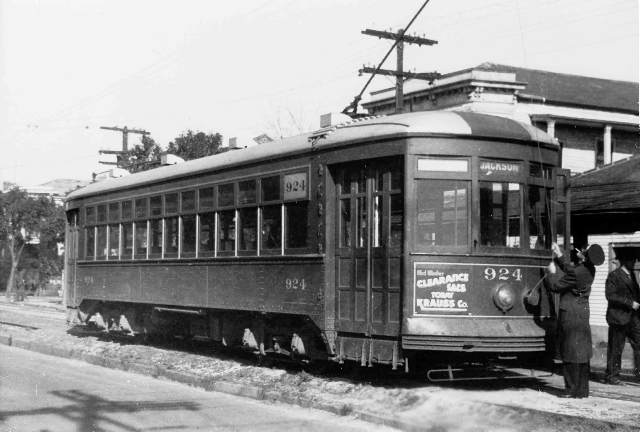 This 1930s view of car 924 catches the motorman in the act of changing ends,
putting up the trolley pole at what will be the trailing end of the car.
This is the river end of the Jackson line. We have another good look at
the frosted glass number panel. Note also the black stripe on the end of
the otherwise light-colored roof, which was intended to hide staining from the
trolley wire and the trolley wheel. — Leo Sullivan collection
This 1930s view of car 924 catches the motorman in the act of changing ends,
putting up the trolley pole at what will be the trailing end of the car.
This is the river end of the Jackson line. We have another good look at
the frosted glass number panel. Note also the black stripe on the end of
the otherwise light-colored roof, which was intended to hide staining from the
trolley wire and the trolley wheel. — Leo Sullivan collection
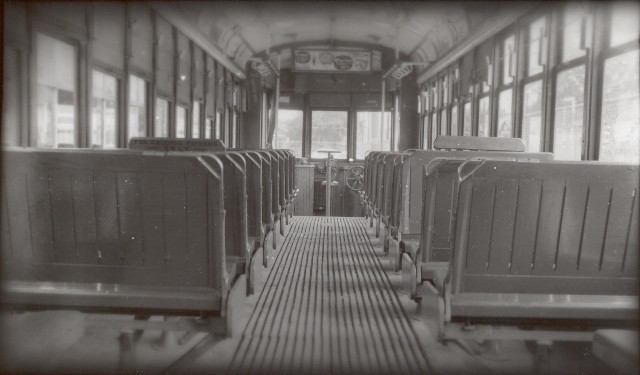 Car 943, shown ca. 1947, shows off its interior appointments.
The slat floors were designed to provide traction for shoes, despite mud and
gravel that might accumulate between the slats. They were replaced in the
1950s with modern rubber tread floors. The conductor's stand can be seen
in the middle of the aisle at the end of the car. To the right at the end
of the car is the large vertical wheel of the emergency hand brake. These
were so seldom used that they were removed during the 1950s and 1960s.
The motorman's stool can be seen behind the conductor's stand, with the
controller at the left. On the post between the windows along the car
sides can be seen the little boxes in which for many years leaflets
entitled Transit Riders' Digest were published weekly. Window
shades are noticeable on the left side of the car; those on the right happen
to all be up. Prominent on top of one seat back on each side of the car
is the Jim Crow sign, which marked the boundary between seating for white and
colored patrons, in accord with Louisiana law. There was a pair of sockets
on top of each seat back so that the signs could be moved forward or back as the
needs might change during the working day. After that law was declared
unconstitutional in 1958, the signs were removed and integrated seating was
quietly implemented on May 31. The brass sockets remained, useless,
until the seat backs were gradually replaced. — Louis Hennick collection
Car 943, shown ca. 1947, shows off its interior appointments.
The slat floors were designed to provide traction for shoes, despite mud and
gravel that might accumulate between the slats. They were replaced in the
1950s with modern rubber tread floors. The conductor's stand can be seen
in the middle of the aisle at the end of the car. To the right at the end
of the car is the large vertical wheel of the emergency hand brake. These
were so seldom used that they were removed during the 1950s and 1960s.
The motorman's stool can be seen behind the conductor's stand, with the
controller at the left. On the post between the windows along the car
sides can be seen the little boxes in which for many years leaflets
entitled Transit Riders' Digest were published weekly. Window
shades are noticeable on the left side of the car; those on the right happen
to all be up. Prominent on top of one seat back on each side of the car
is the Jim Crow sign, which marked the boundary between seating for white and
colored patrons, in accord with Louisiana law. There was a pair of sockets
on top of each seat back so that the signs could be moved forward or back as the
needs might change during the working day. After that law was declared
unconstitutional in 1958, the signs were removed and integrated seating was
quietly implemented on May 31. The brass sockets remained, useless,
until the seat backs were gradually replaced. — Louis Hennick collection
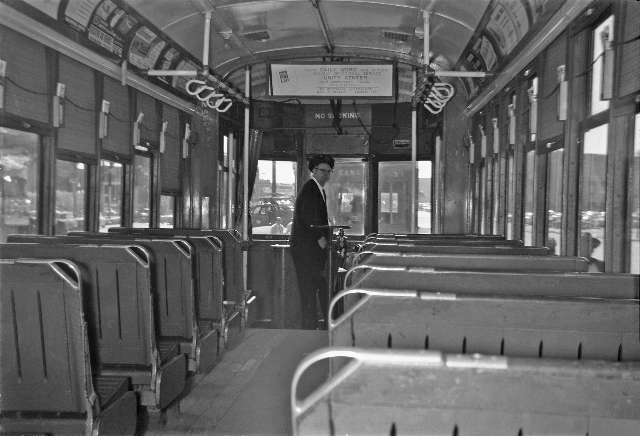
An interior view of car 944 as it lays over at the foot of Canal Street, March 21, 1960.
Near the motorman's right hand is the conductor's stand, for use when that end
of the car is trailing (and thus is the conductor's station). We can see
a double row of porcelain-surfaced hand holds; these were spring-loaded to swing
into this out-of-the-way position when not in use by standing passengers.
Note on the seat backs the brass handles for standing passengers, and next to
the handles, one of the sockets originally used for the Jim Crow signs; the
matching socket is barely visible on some of the seat backs, toward the
window. Little bunches of copies of Transit Riders' Digest sit in
their holders between windows waiting to be taken and read.
— J. G. Lachaussee photo
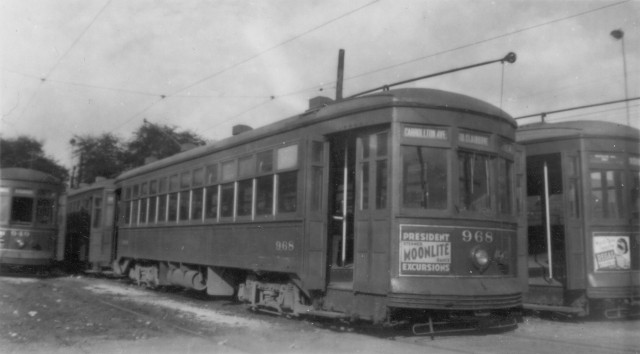
Car 968 was one of only a few cars in the 900 series that had two-piece
steps in the front, right side, for exiting passengers. The doors were
arranged so that one door (two panels) could remain closed, and the other
paired door could open. This photo was taken around 1947, probably at
Arabella Station. The car is signed for the S. Claiborne line, with a
destination sign reading “Carrollton Ave.” (the normal end of the line).
Other cars known to have this door arrangement around this time include 953, 956,
962, 967, and 971. A very few 900s had this feature on the rear right side, for
entering passengers; 909, 947, and probably 963 are known in photographs.
No cars are known to have had these “double steps” on both front and rear doors
simultaneously. None of these arrangements survives today.
— Otto Goessl photo, Louis Hennick collection
More changes took place during the 1940s. Ad signs appeared on R. H.
dashes of 800s, 900s and 1000s about 1941, while the 400s had such dash ads
placed on the L. H. Ad signs appeared on all cars' sides, left end,
starting about 10 years later. About 1950, NOPSI began replacing
trolley wheels with carbon slide shoes (like most such changes, the completion
may have taken months, car by car). In the late 1950s trolley coach
poles began replacing the older poles and bases ... a change that took years.
When Canal was bussed in 1964, a few cars still had the old four-spring swivel
bases. Starting about the same time, the car numbers on sides and dashes
were reduced in size. The 900s never had screen over windows such as
the 800s. In the late 1950s some 900s (and one 800) were fitted with
black and yellow metal “guards” above entrance steps. This was soon
eliminated, but two other changes were permanent: rear view mirrors came
as well as replacement of the wooden strips on floors with a rubber walkway
strip, eliminating ladies getting high heel shoes stuck, and giving a
slip-free surface. Interiors of some cars were painted a
light powder blue. (For P of black & yellow “guard” see S p. 158
car 904.)
A few 900s had door locks, a tiny keyhole on the last panel, rear doors.
These are known on some cars in the 940s and 950s, in the later 1940s and early
1950s. No photos are known.
The first RB Program was more finding a better design.
There were different efforts entailing over a dozen cars, from ca. 1960
to 1964, when a systemwide model was adopted: from SCB 4/10/63 by E. Harper
Charlton, Wilbur T. Golson, and Otto A. Goessl.
| | 914, 915 | RB Dec. 1961 —
Rounded blue tinted bus type standee windows repl. upper sash, new steel
doors, cars repainted, no louvres. |
| | 937 | Same, but not repainted,
doors not repl., silver strips & white stauncions. |
| | 911, 920 | Same oval
standees, doors as 914. No ventilators but 5 louvres in letterboard.
P - S p. 158. |
| | 959 | First St. Charles car
to be RB, like 937 but with aluminum roof only (EWH). |
| | 900, 922 | Aluminum roofs,
trolley coach poles, larger door windows than 911, 914, 920.
900 first w/o ventilators. |
| | 932 | Like 922 except larger
upper sash, no tint. Motors RB, new wheels. |
| | 948, 968, 971 |
Like 932 except conductor's stand & door handles chrome plated. |
| | 906 | Like 968 except no RB
motors, no new rewiring. |
| | 907 | Same except air door
handles not chrome plated. |
| | 965, 969 | Undergoing RB
at Carrollton Station at the time. |
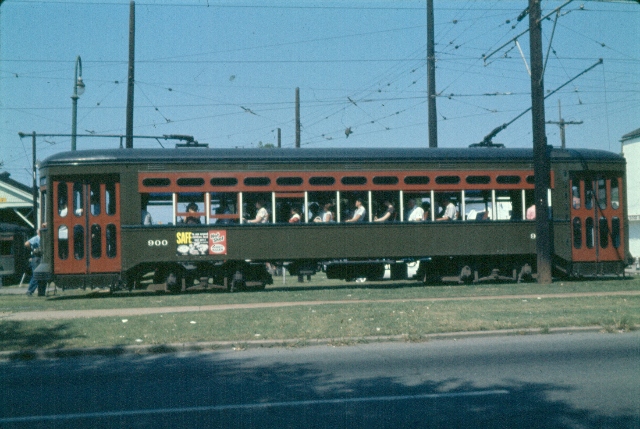 |
This August 1962 photo shows off car 900, outbound on the Canal Line
with Canal Station in the background. We have a good view of the aluminum
roof without ventilators, the new steel doors with more glass panels than the old
wooden doors, and the bus-style standee windows in the upper window sash.
— Earl Hampton collection |
The second RB Adopted 1963, well under way in 1964 for the 35 900s
retained for service on the St. Charles Line. P - S p. 157.
Trucks RB with new solid WH to reduce noise. All cars - aluminum roof.
Segregation signs gone ca. 1957-58. The brass
fittings on upper edge seat backs to hold the signs slowly disappeared as
seats were renewed. Even the old controller handle wooden knobs repl.
by substitute hard black substance. Cars 947-972, except for 954, had
electric foot pedals for ringing fares,
and the rest of the 35 cars had manual system. It was said, the older
conductors got cars with the elec. pedals. One exception to the 900-945
group: 914 had elec. foot pedals. Doors had a subtle color change - to
“seminole brown” - interior a light blue, but ceilings - white preferred
(blue ceilings only a short time).
The third RB By 1967, NOPSI realized the St. Charles Line was going
to be around for a longer time than imagined. All 35 cars over a couple
of years again RB, looking like 2nd RB, with any structural features RB where
needed. First two cars; 900 with all aluminum windows, 933 keeping
wooden windows. Next 903-907, and afterwards no order. Interior,
final change from “deep blue & powder blue ceiling” to lime green with
white ceiling (green paint more economical).
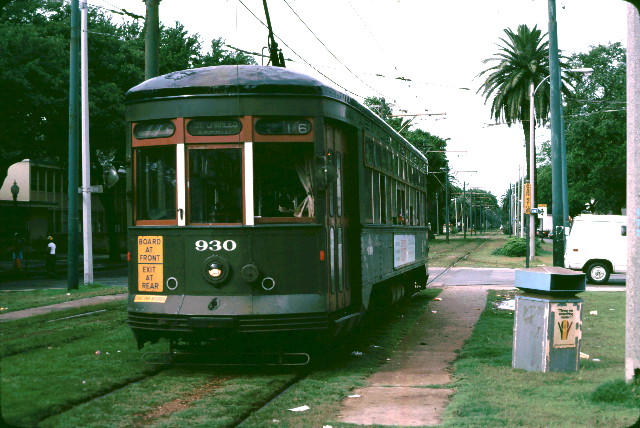 |
One of the unsuccessful experiments tried out in the 1970s involved the
installation of a pair of red tail lights on the end dash panels, as seen
in this photo of 930, dated May 23, 1979. After it was
decided not to adopt them for the fleet, they were removed from the experimental
cars and the holes were patched, as seen in this Sept. 17, 1981 picture of 923.
Eventually, the patched dash panels were replaced. — George Friedman collection |
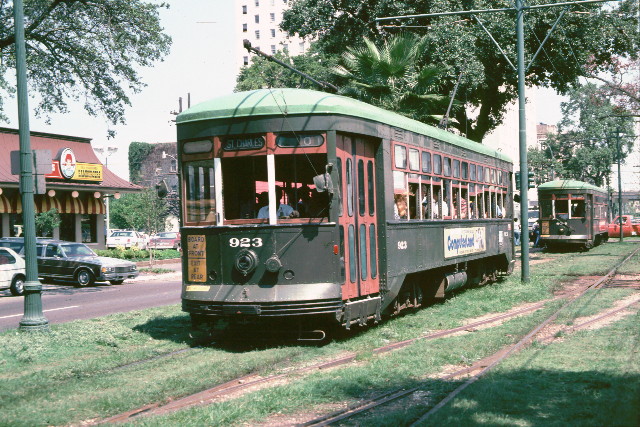
|
Text copyright © 2008 Louis C. Hennick.
Pictures copyright © 2011 by the persons credited.
Picture captions copyright © 2011 H. George Friedman, Jr. and Louis C. Hennick.
All rights reserved.
x
Previous Page |
Next Page
Appendix III Title Page & Contents
Computer Science Department,
University of Illinois at Urbana-Champaign, Home Page
H. George Friedman, Jr. Home Page
 Car 925 on December 14, 1929, only about five years after its delivery from
the Perley Thomas Car Co. The car is seen just about in as-delivered
condition. The only obvious change is the sign on the front dash, which
warned strikers about the federal injunction against interference in operation.
The car is at Arabella Station, signed for service on the Louisiana line.
We have a glimpse of a Brill Semi-convertible in the right background.
— Louis Hennick collection
Car 925 on December 14, 1929, only about five years after its delivery from
the Perley Thomas Car Co. The car is seen just about in as-delivered
condition. The only obvious change is the sign on the front dash, which
warned strikers about the federal injunction against interference in operation.
The car is at Arabella Station, signed for service on the Louisiana line.
We have a glimpse of a Brill Semi-convertible in the right background.
— Louis Hennick collection Early in their lives, the 900s sported a frosted glass car number panel
in the upper sash of the first window behind the front doors. At night,
the car lights shone through, illuminating the car number. These were
discontinued during WW II. This 1938 photo of car 923 was taken at the uptown end
of the Magazine line along the side-of-the-road trackage through Audubon Park.
Note the waiting shelter at the far right. — Leo Sullivan collection
Early in their lives, the 900s sported a frosted glass car number panel
in the upper sash of the first window behind the front doors. At night,
the car lights shone through, illuminating the car number. These were
discontinued during WW II. This 1938 photo of car 923 was taken at the uptown end
of the Magazine line along the side-of-the-road trackage through Audubon Park.
Note the waiting shelter at the far right. — Leo Sullivan collection This 1930s view of car 924 catches the motorman in the act of changing ends,
putting up the trolley pole at what will be the trailing end of the car.
This is the river end of the Jackson line. We have another good look at
the frosted glass number panel. Note also the black stripe on the end of
the otherwise light-colored roof, which was intended to hide staining from the
trolley wire and the trolley wheel. — Leo Sullivan collection
This 1930s view of car 924 catches the motorman in the act of changing ends,
putting up the trolley pole at what will be the trailing end of the car.
This is the river end of the Jackson line. We have another good look at
the frosted glass number panel. Note also the black stripe on the end of
the otherwise light-colored roof, which was intended to hide staining from the
trolley wire and the trolley wheel. — Leo Sullivan collection Car 943, shown ca. 1947, shows off its interior appointments.
The slat floors were designed to provide traction for shoes, despite mud and
gravel that might accumulate between the slats. They were replaced in the
1950s with modern rubber tread floors. The conductor's stand can be seen
in the middle of the aisle at the end of the car. To the right at the end
of the car is the large vertical wheel of the emergency hand brake. These
were so seldom used that they were removed during the 1950s and 1960s.
The motorman's stool can be seen behind the conductor's stand, with the
controller at the left. On the post between the windows along the car
sides can be seen the little boxes in which for many years leaflets
entitled Transit Riders' Digest were published weekly. Window
shades are noticeable on the left side of the car; those on the right happen
to all be up. Prominent on top of one seat back on each side of the car
is the Jim Crow sign, which marked the boundary between seating for white and
colored patrons, in accord with Louisiana law. There was a pair of sockets
on top of each seat back so that the signs could be moved forward or back as the
needs might change during the working day. After that law was declared
unconstitutional in 1958, the signs were removed and integrated seating was
quietly implemented on May 31. The brass sockets remained, useless,
until the seat backs were gradually replaced. — Louis Hennick collection
Car 943, shown ca. 1947, shows off its interior appointments.
The slat floors were designed to provide traction for shoes, despite mud and
gravel that might accumulate between the slats. They were replaced in the
1950s with modern rubber tread floors. The conductor's stand can be seen
in the middle of the aisle at the end of the car. To the right at the end
of the car is the large vertical wheel of the emergency hand brake. These
were so seldom used that they were removed during the 1950s and 1960s.
The motorman's stool can be seen behind the conductor's stand, with the
controller at the left. On the post between the windows along the car
sides can be seen the little boxes in which for many years leaflets
entitled Transit Riders' Digest were published weekly. Window
shades are noticeable on the left side of the car; those on the right happen
to all be up. Prominent on top of one seat back on each side of the car
is the Jim Crow sign, which marked the boundary between seating for white and
colored patrons, in accord with Louisiana law. There was a pair of sockets
on top of each seat back so that the signs could be moved forward or back as the
needs might change during the working day. After that law was declared
unconstitutional in 1958, the signs were removed and integrated seating was
quietly implemented on May 31. The brass sockets remained, useless,
until the seat backs were gradually replaced. — Louis Hennick collection



